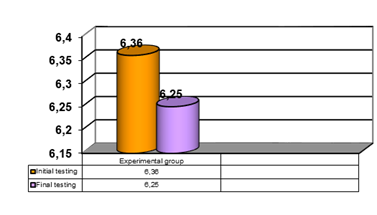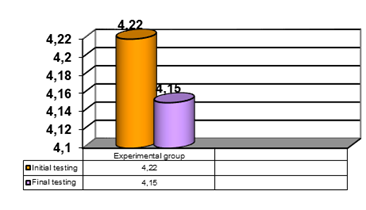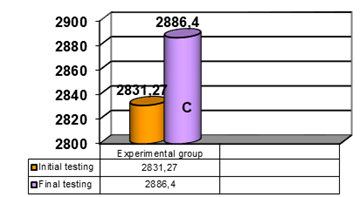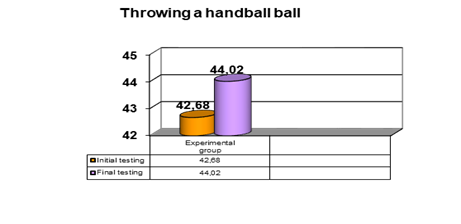Abstract
The motto of the current handball game is indisputably transformed, permanently centered on a series of positive trends aimed at increasing the game speed and its spectacularity, which cannot be conceived without the highest level of the motoring qualities. Thus, players are required to have a speed in all its forms (reaction, decision, travel, etc.), increasing segmentation force required for throwing and jumping, segment coordination, mobility, but also resistance to stress and stress. At the level of children and junior teams of real importance is the development of motor and psychomotricity qualities depending on the age stages in which they can be influenced more strongly, which is the support of the correct appropriation of technical procedures and tactical actions. In order to accomplish the present research, we performed a longitudinal experiment at the level of a junior handball team, participating in the Junior Juniors Championship, in which we implemented a series of selected and dosed means according to the age and training peculiarities of the athletes and in full in accordance with the current handball game's motoring structure;
Keywords: Handballjuniorsmotor qualities
Introduction
At the level of junior handball teams, the training and performance goals must be in full compliance with their age and training prerequisites, with periods and stages in which certain priorities must prevail. The motoring qualities, in all their manifestations, are present in the handheld structure of the handball game at this stage of performance, so that a high degree of their development will have positive effects on the player's field manifestation, both for the attack game as well as for the defense. The physical characteristics and anthropometric characteristics of the athletes for each playground, along with the driving characteristics of the game's motive structure, can be key factors contributing to success in team sports. The handball game and everything that confers the complexity of sports training is in a continuous evolution and certainly with a constantly accelerated dynamics, the game and gamer model being "in full agreement with the motric structure of the actions undertaken by each player during the course phases of attack and defense game" (Mihăilă, 2013, p. 16).
Problem Statement
The objectives of the junior echelon II training are represented by the continuous development of the basic and specific motor skills, the improvement of the basic technique in diversified conditions, close to the game, the deepening of the specialization on the positions and the individual game tactics, the subordination of the actions individual requirements imposed by attack and defense systems. Studies show that multilateral development has advantages over specialization in time, over time. These advantages are outlined in the longevity of the sports career, the drop in the risk of abandonment, the constancy in performance and, last but not least, the less injuries.
Modelling the training of beginner children in handball, age echelon, and game play, in relation to the current handball dynamics, will result in optimizing their performance in training and competition. Specialization must be achieved after the athlete has developed a solid multilateral basis, but with the approach of specialization, training must include exercises that continue to develop general motor skills. Achieving higher indices of specific physical training is all the more necessary as these are indices that materially convey the performance of athletes in gaming conditions, the specific physical training being the one that brings the individual qualities closer to handball specific requirements.
Bompa (2013) believes that not so much play, especially training, it helps to improve the technical and tactical techniques of the athlete and develops all the physical components that allow him to cope with fatigue.
Research Questions
The modelling of the training of the handball players on stages and training samples is based on the model developed by the field specialists following theoretical studies and practical observations, a constantly changing model, due to the ever-changing driving force of the handball game. Permanent search for the most effective methods and means of training leading to higher results is a topical theme for all performance handball echelons. Our study aims to experimentally verify, through a longitudinal study at the level of a junior handball team, some actuation systems selected and dosed according to the age and training characteristics of the athletes, but also with the motric structure and specificity of the current handball game effort. The handball game and everything that confers the complexity of sports training is in a continuous evolution and certainly with a constantly accelerated dynamics.
In all aspects of the game and modern sports training, there are numerous elements of progress, improvement, absolute novelties, but also some upgrades of the superior parameters.
Purpose of the Study
In handball, specific physical training aims to ensure that there are increased indexes of general and specific driving qualities needed by players to cope with the demands of the effort required by the ever-increasing dynamics of the game, which "serves as a transition from general physical training at the competitive stage "(Bompa & Haff, 2014, p.59). In Trosse's view (2004), physical training is considered to be an important foundation of performance in play, while inadequate physical training slows down and reduces the effectiveness of technical tactical training, limits specific effort, increases performance instability, slows down the process rehabilitation, favouring a series of injuries. If the "training model attempts to simulate or reproduce elements of competitive game situations in order to increase team efficiency" (Bompa, 2013, p. 107), the modelling of the physical training and implicitly of the motor skills involved in the structure of the game handball at the junior team of 16-18 years old is a real and permanent topic of relevance to this performance echelon, given that only on a solid skeleton of motoring qualities we can build the other factors of sports training, imperative to achieve sporting performance. At the level of junior echelon, "the means used to develop motor skills must be rigorously selected, eliminating those that have an insignificant effect. They must be varied and attractive" (Kunst-Ghermănescu, Gogâltan, Jianu, & Negulescu, 1983, p.261).
Research Methods
For the realization of the present research a series of research methods were used, specific to the field of Science of sport and physical education, with a high degree of applicability at the level of the experimental works, respectively: study of specialized literature, pedagogical observation, experimental method, statistical / mathematics and graphic method.
Findings
In order to evaluate the level of development of the motor skills directly involved in the current handball game structure, a number of four control samples considered to be representative were selected, the results of the initial testing being presented in Table
The longitudinal experiment at the level of a junior handball team II took place over a period of six months, during which the athletes participated in a series of individualized training programs in the hall or in the open air and which had as their main objective the development the driving skills directly involved in the handball game. At the end of the research, the athletes again passed the same control samples, the results being recorded in Table
The dribble control test among the probes records a 6.36 second arithmetic mean value for the final test to achieve a 0.11 seconds progress (6.75 seconds arithmetic mean). The values of the standard deviation and the coefficient of variability indicate a high uniformity of performance of the athletes in both tests but with higher values in the final test (Figure

30 m speed run - The components of the experimental group record a 4.22 second arithmetic average with a standard deviation of 0.06 seconds and a coefficient of variation of 1.43% (high homogeneity) so that a 0.07 seconds progress is recorded in the final test, the arithmetic mean being 4.15 seconds with a standard deviation of 0.04 seconds and a 0.83% coefficient of variation (high homogeneity) (Figure

The 12-minute Run Cooper test records for the subjects under investigation in the initial test an arithmetic mean value of 2831.27 m with a standard deviation of 122.38 m and a coefficient of variation of 4.33% that falls within the threshold of high homogeneity. At the final test, a progress of 55.13 m is recorded, the arithmetic mean value being 2886.4 m with values of the standard deviation and the coefficient of variability higher than the initial test ((Figure


In the control test, throwing the 3-step handball ball, the initial test records for players of the experimental group an arithmetic mean value of 42.68 m with a standard deviation value of 1.23 m and a coefficient of variability falling within the high homogeneity threshold, namely 3.19%. At the end of the research there is a progress of 1.34 m, the performance of the athletes being 44.02 m with a lower standard deviation and a higher coefficient of variability (2.81% - within the high homogeneity threshold) (Figure
Conclusion
The general and handheld qualities of the handball game developed during the physical training stages are a basic basis for sports training at all performance handheld echelons and a condition for obtaining superior results in training and competitions. In the sports training of handball teams it is very important to know the type of effort, the energy sources, the percentage of aero-anaerobic processes so that the training programs designed to increase the physical potential of the players and to have positive transfers over the other factors of the sport training, according to the principle that "the training of a motoring quality is positively reflected on the other qualities" (Voicu, 2003, p. 45). The values of the main indicators of statistical mathematics that have been calculated shows that the final testing research subjects have achieved higher values of the arithmetic mean of all control samples, and the degree of high homogeneity (0-10%) improves the end, which demonstrates the efficiency of the drive systems experienced in practice.
References
- Bompa, T. (2013). Antrenamentul pentru sporturile de echipă [Training for team sports]. București: C.N.F.P.A.
- Bompa, T. O., & Haff, G. G. (2014). Periodizarea. Teoria și metodologia antrenamentului [Periodization. Theory and methodology of training]. București: Point Promo.
- Kunst-Ghermănescu, I., Gogâltan, V., Jianu, E., & Negulescu, I. (1983). Teoria și metodica handbalului [The Handball Theory and Methodology]. București: Didactică și Pedagogică.
- Mihăilă, I. (2013). Handbal. Teoria jocului [Handball. Game theory]. Pitești: Universității.
- Trosse, H. D. (2004). Balonmano. Ejercicos y programs de entrenamiento [Handball. Exercises and training programs]. Barcelona: Hispano Europea.
- Voicu, S. F. (2003). Handbal. Pregătirea pentru performanță [Handball. Preparing for performance]. Timișoara: Universității de Vest.
Copyright information

This work is licensed under a Creative Commons Attribution-NonCommercial-NoDerivatives 4.0 International License.
About this article
Publication Date
15 August 2019
Article Doi
eBook ISBN
978-1-80296-066-2
Publisher
Future Academy
Volume
67
Print ISBN (optional)
-
Edition Number
1st Edition
Pages
1-2235
Subjects
Educational strategies,teacher education, educational policy, organization of education, management of education, teacher training
Cite this article as:
Mihaila*, I., & Stanescu, S. (2019). Modeling The Motor Quality At The Level Of Junior Handball Teams. In E. Soare, & C. Langa (Eds.), Education Facing Contemporary World Issues, vol 67. European Proceedings of Social and Behavioural Sciences (pp. 1207-1212). Future Academy. https://doi.org/10.15405/epsbs.2019.08.03.148
